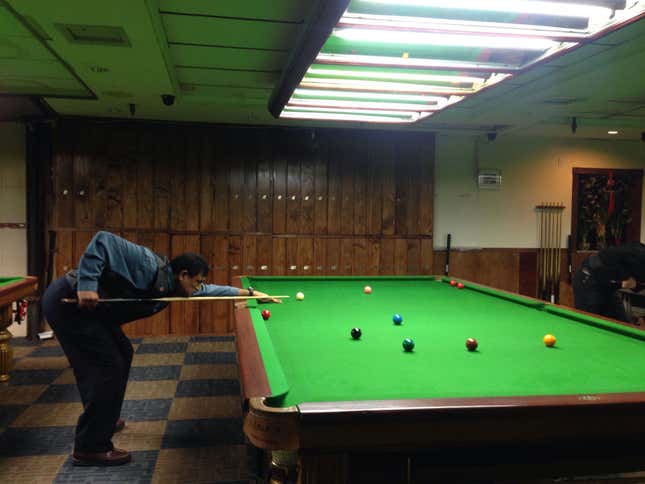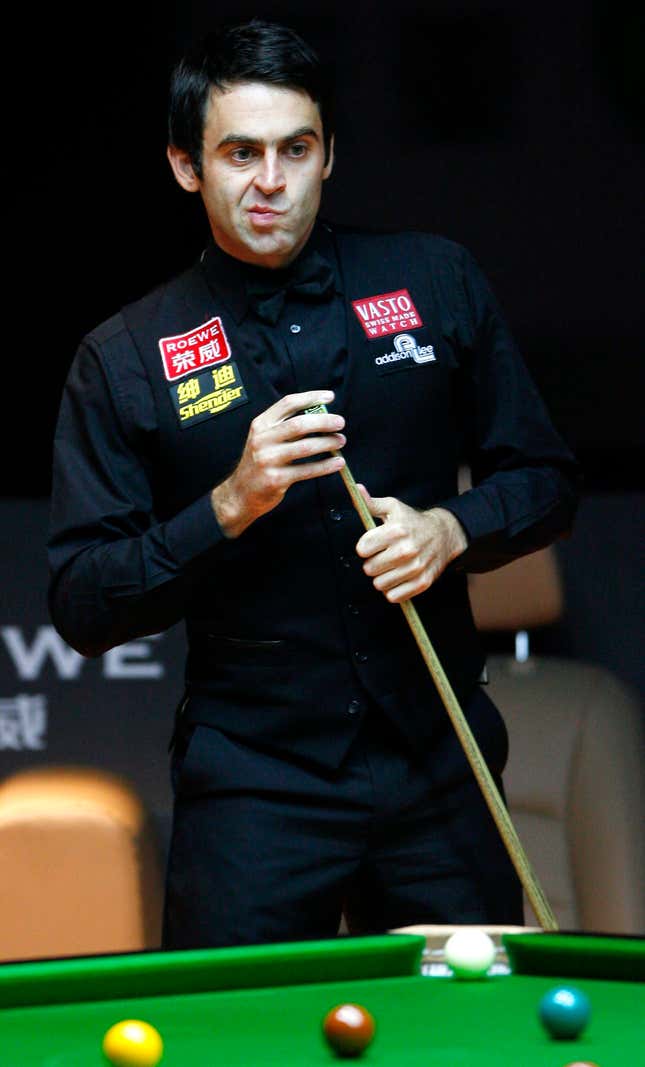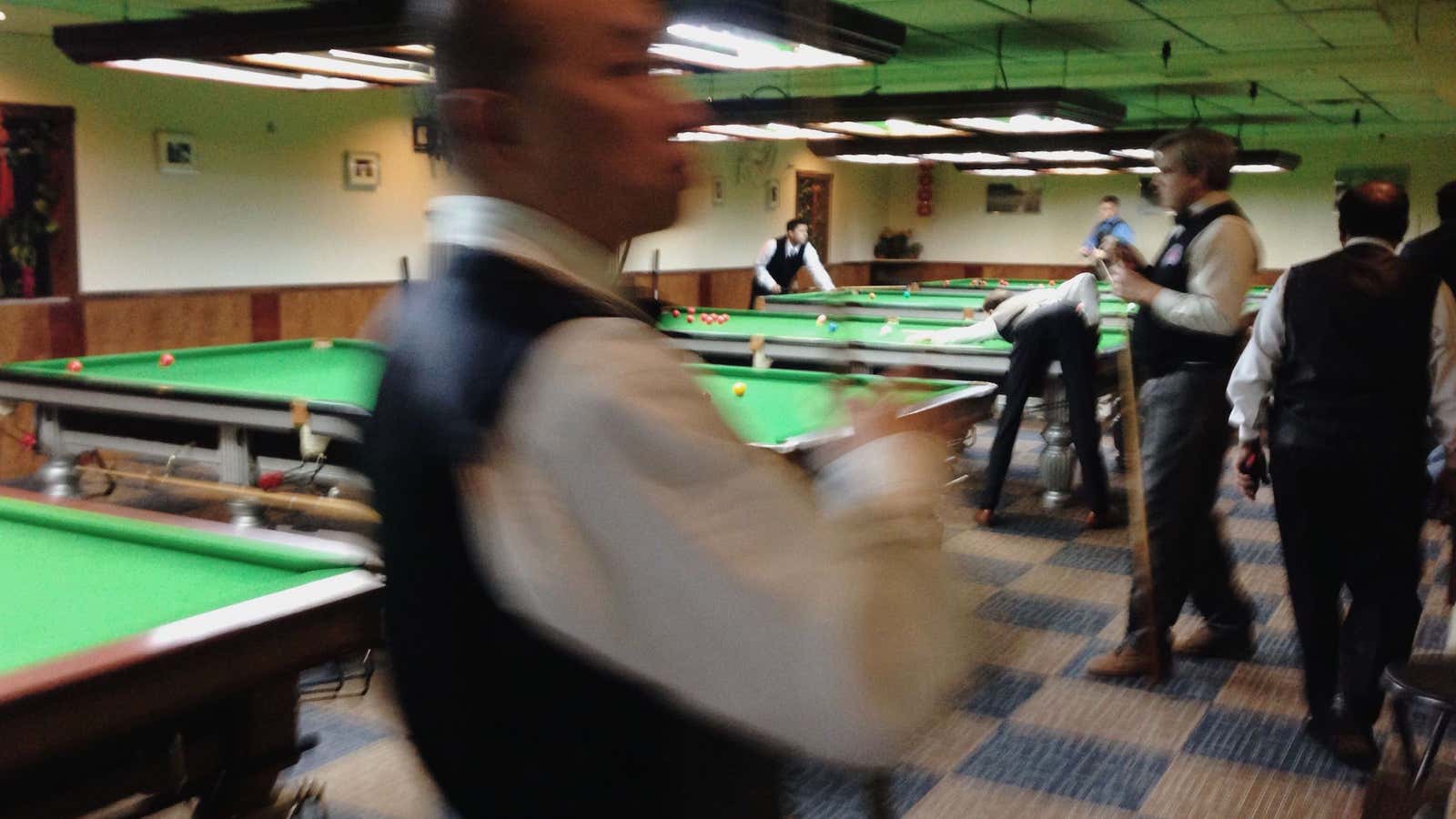Today, two of the best snooker players in the world meet in York, England for the final of the UK Championship, the second-most prestigious event on the sport’s calendar. One of the finalists is Ronnie O’Sullivan, perhaps the most naturally-gifted player to practice the sport.
He plays snooker like a combination of Pythagoras and Pele, lining up sublime shots at angles that defy logic as he switches from right- to left-handed without thinking about it. The BBC called him “the Da Vinci of the baize,” referring to the green felt that hugs the snooker table, and compared him to Mayweather and Federer, insomuch as he turns his sport into an art.
Alas, few people in America will have heard of O’Sullivan or even the sport of snooker. Snooker has never had a moment in the US. Barry Hearn, the man who runs professional snooker, isn’t sure it ever will. “The American psyche is all about results and crash, bang, wallop,” he tells Quartz. “Do they have the ability to appreciate something that takes time and is cultured?”
A few people are trying to prove they can. In May, Quartz visited the National Snooker Championship, the most prestigious event in US snooker, which took place in the Top 147 Snooker Club, behind an unmarked door in Bay Ridge, Brooklyn. The players were dressed in the standard outfit for the sport of snooker—a shirt, waistcoat and bow tie.
Well, all except for one young man in a yellow shirt and electric-blue sneakers. He played the game as if it were pool, the white ball ricocheting off the cushions with wild abandon. Vacuum cleaners and printers lay under the snooker tables. Despite the ban, people smoked indoors.
Most of the players were born abroad. Raymond Fung, who played back in Hong Kong, now calls Brooklyn his home. “Here, we call it an immigrant game,” he said. “It’s not for the local people.” Because of a change in rules that stated that only American citizens could play, there were 20 competitors, instead of the usual 32 or so. The club, like most businesses in the area, is Chinese-owned and a toy golden cat watched the proceedings, its arm perpetually waving.
Ajeya Prabhakar, an India-born engineer based in San Jose, was the tournaments No. 2 seed. “There is huge potential,” Prabhakar told Quartz, pointing to the large numbers of pool players who could be converted to the game.

Chris Bruner, a 22-year-old from Richmond, Virginia, who plays on the amateur pool circuit, was one of the few people in the room to have been born in the US. “I’ve always been a fan of snooker,“ he says, pronouncing it snucker, as many Americans do. “This is mainly a bucket-list item for me to do as far as things that are cue sports-related. I don’t really have the highest of expectations.”
Pool players often struggle to make the leap. Last year’s US national champion was not at the tournament, because he took the chance to compete at an event in England for a place on the pro circuit —and quickly lost both his matches. This year, Bruner made it to the last 16 before he was knocked out.
The highest an American player has ever reached in professional snooker was Jim Rempe, who was ranked 101st during the 1987-88 season. Does Bruner think snooker could become a legitimate sport in the US? “Once people get accustomed to learning the points and learning the colors, I think it could take off. I really do.”
Snooker, which has its origins in billiard games played by British Army officers in colonial India, is a remarkably difficult and delicate sport. Many players focus on potting the reds and colors—but the real skill of the game is the sublime way players move the white ball around. A good player is always setting up the next shot. Around this huge table with tiny pockets, it is Newton’s laws of physics applied to chess. In snooker, a single mistake is usually enough.
And when a player gets the run of the balls, the colors seem to melt into the pockets. A game can take hours but in 1997, O’Sullivan, cleared the table during a match in less than six minutes, the fastest maximum break ever.
In 2012, shortly after winning his fourth world title, the mercurial O’Sullivan announced he was taking a break from the sport, citing personal issues that have included drug and drink addiction, a father in prison for murder, and a long battle with depression. Yet, after a year of self-imposed exile, playing only one competitive match, he returned in 2013 and beat the best in the world to retain his world title—an unprecedented feat. O’Sullivan claimed he was playing only because he was behind on his son’s school fees. After his win, many of his rivals called O’Sullivan the greatest of all time.
The last World Championship final in May, which O’Sullivan lost to Mark Selby, was a best-of-35 match that takes place over two days that was watched by as many as 5 million people in the UK, but more importantly, a total of 331 million across the world, its highest ever global reach, with the majority in China. The man responsible for this international expansion is Hearn, the plain-spoken British darts and boxing promoter who took control of World Snooker, the professional sport’s governing body, in 2010.

“When I arrived, the sport was moribund,” Hearn tells Quartz. “People were complacent. It was a long way from the peak of the Eighties.” In 1985, 18 million people in Britain watched the final between Steve Davis and Dennis Taylor, which went on well past midnight. Hearn borrowed some razzmatazz from another sport he runs, darts, playing up nicknames (“The Jester from Leicester”) and theme music, and proceeded to expand the number of tournaments from six to 30, with most of them taking place in countries such as India and China, where the sport is surging in popularity. “We went to countries where the sport is growing,” Hearn said. “It’s not rocket science.”
The total prize money on the circuit has more than doubled to more to almost $15 million. The sport is also expanding rapidly in Europe, especially to the east. The German Masters draws the largest crowds of anywhere in the world. But despite strides around the rest of the world, America has yet to be persuaded of the game’s charms.
For the near future, there’s some talk of bringing O’Sullivan to play an exhibition match against China’s highest-ranked player, in Las Vegas “for the Chinese gamblers.” But Hearn says that no-one will pay him enough in TV broadcasting rights to make a US tournament worthwhile. “An American audience would never understand why a semi-final takes three days,” Hearn tells Quartz. “Some sports don’t translate to other countries and you have to accept that.”
In Brooklyn, they may have been amateurs but they took it seriously. Ahmed Aly Elsayed, the Egyptian former three-time US champion, was in tears after he was knocked out. “Most of the players don’t play regularly,” said Prabhakar, “and you can tell. Once you come to the US, your snooker dies.”
Prabhakar played in India and finished sixth in 1991 in the World Junior Championships, which was won by a certain Ronnie O’Sullivan. “After the first frame, we broke off and he quickly cleared the table,” Prabhakar recalled. “I quickly realised Ronnie’s in a different league. It was a revelation.”
One semi-final at the Brooklyn tournament took six hours to finish—and that was for just seven games of snooker. For many, this would have been the most boring afternoon of their lives. In this room, everyone was spellbound. No-one could wait for the final—which would be Prabhakar vs. Fung. As well as a player, the affable Prabhakar is also the president of the US Snooker Association. “They’re going to say it’s a set-up!” he laughed.
When he became president in 2008, there was just the national championship. Last year, they had 11 mostly regional tournaments. “Right now, what we need is more support from the World Snooker organization and maybe bringing a professional tournament here and trying to get it on television,” he said.
Part of how Prabhakar wants to popularize the game in America is to take the game of snooker and put it on a pool table. “It’s like an introduction to snooker for pool players,” he said. “So for the pool hall owners, you don’t need to invest in the snooker tables until the players are ready. We’re trying to see if we can get special balls made.”
When this was put to him, Hearn was unconvinced. “Once you start compromising the game, the natural asset is wasted,” he said. “There’s nothing wrong with the rules of the game. The game has a proven record of entertaining millions of people.”
Fung and Prabhakar began their best-of-nine match with the winner’s trophy placed off to one side next to a Dunkin Donuts iced coffee. The lights had been turned off on the other tables; a single harsh fluorescent light focused on the baize made it appear as though they were playing snooker on a pond of glowing algae. Prabhakar stalked the table with his hand in his pocket—a very stressed man trying to appear nonchalant. O’Sullivan cites money as one of his primary motivations for playing, and that’s understandable with $500,000 in prize money on the line in the world final. But for the amateur to keep playing the sport out of your pocket year after year is entirely different kind of commitment. After winning the tournament 14 years ago, Prabhakar had since lost four finals but he kept on playing. The prize purse this year was $800. “It’s more expensive than that just to be here,” he said.
In one frame, the black ball was dead, seemingly lost in no-man’s land off to the side. But Prabhakar sunk a blue and made sure the white headed straight for the black, smacking it off the cushion and back into open play. It was beautiful play. As is tradition, Fung tapped the table in appreciation.
In another frame, with both needing to win but each also concerned about setting up their opponent for a game-winning shot, Fung and Prabhakar took it in turns to push the white and red balls to opposite ends of the table, making it the longest and most difficult shot for the next man. The game shifted to the sort of attritional warfare that Barry Hearn laments Americans find boring.
Yet Prabhakar is convinced that snooker in America will have its day. “Golf is very slow and it’s really popular in the US. Why not snooker?” He is already planning to increase the number of tournaments held around America.
“We want to prove Barry wrong,” he said.
Prabhakar went on to win the match and become the 2014 US champion.
